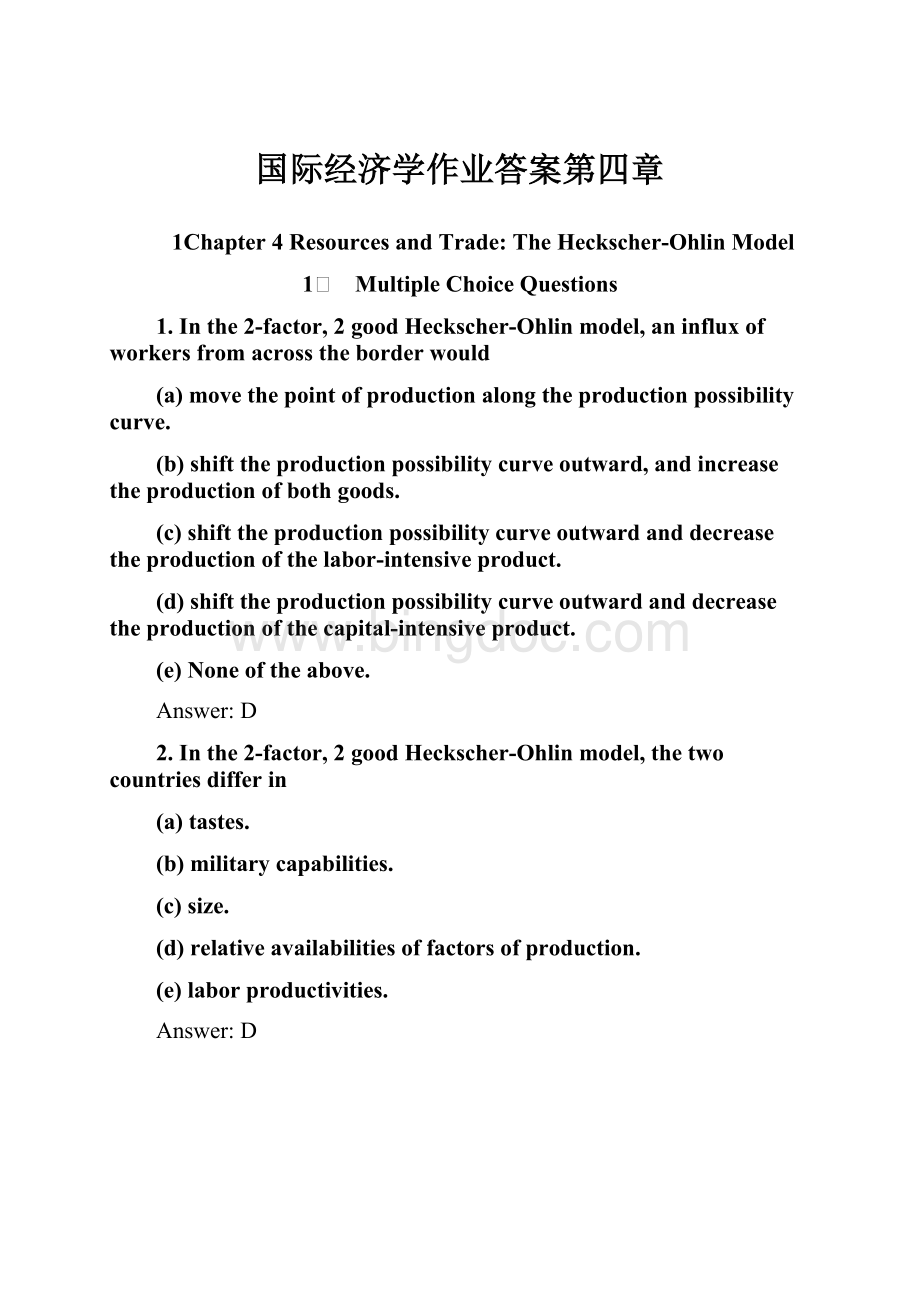国际经济学作业答案第四章.docx
《国际经济学作业答案第四章.docx》由会员分享,可在线阅读,更多相关《国际经济学作业答案第四章.docx(30页珍藏版)》请在冰点文库上搜索。

国际经济学作业答案第四章
1Chapter4ResourcesandTrade:
TheHeckscher-OhlinModel
1n MultipleChoiceQuestions
1.Inthe2-factor,2goodHeckscher-Ohlinmodel,aninfluxofworkersfromacrosstheborderwould
(a)movethepointofproductionalongtheproductionpossibilitycurve.
(b)shifttheproductionpossibilitycurveoutward,andincreasetheproductionofbothgoods.
(c)shifttheproductionpossibilitycurveoutwardanddecreasetheproductionofthelabor-intensiveproduct.
(d)shifttheproductionpossibilitycurveoutwardanddecreasetheproductionofthecapital-intensiveproduct.
(e)Noneoftheabove.
Answer:
D
2.Inthe2-factor,2goodHeckscher-Ohlinmodel,thetwocountriesdifferin
(a)tastes.
(b)militarycapabilities.
(c)size.
(d)relativeavailabilitiesoffactorsofproduction.
(e)laborproductivities.
Answer:
D
3.Inthe2-factor,2goodHeckscher-Ohlinmodel,achangefromautarky(notrade)totradewillbenefittheownersof
(a)capital.
(b)therelativelyabundantfactorofproduction.
(c)therelativelyscarcefactorofproduction.
(d)therelativelyinelasticfactorofproduction.
(e)thefactorofproductionwiththelargestelasticityofsubstitution.
Answer:
B
4.Inthe2-factor,2goodHeckscher-Ohlinmodel,achangefromautarky(notrade)totrade
(a)willtendtomakethewagesinbothcountriesmoresimilar.
(b)willequalizethewagesinbothcountries.
(c)willtendtomakethewagesinbothcountrieslesssimilar.
(d)willtendtomakewagesequaltoreturnstocapital.
(e)willtendtomakerentsequaltointerestrates.
Answer:
A
5.TheLeontieffParadox
(a)supportedthevalidityoftheRicardiantheoryofcomparativeadvantage.
(b)supportedthevalidityoftheHeckscher-Ohlinmodel.
(c)failedtosupportthevalidityoftheRicardiantheory.
(d)failedtosupportthevalidityoftheHeckscher-Ohlinmodel.
(e)provedthattheU.S.economyisdifferentfromallothers.
Answer:
D
6.TheLeontieffParadox
(a)referstothefindingthatU.S.exportsweremorelaborintensivethanitsimports.
(b)referstothefindingthatU.S.Exportsweremorecapitalintensivethanitsexports.
(c)referstothefindingthattheU.S.producesoutsideitsEdgeworthBox.
(d)stillaccuratelyappliestotoday’spatternofU.S.internationaltrade.
(e)referstothefactthatLeontieff—anAmericaneconomist—hadaRussianname.
Answer:
A
7.The1987studybyBowen,LeamerandSveikauskas
(a)supportedthevalidityoftheLeontieffParadox.
(b)supportedthevalidityoftheHeckscher-Ohlinmodel.
(c)usedatwo-countryandtwo-productframework.
(d)demonstratedthatinfactcountriestendtousedifferenttechnologies.
(e)provedthattheU.S.’scomparativeadvantagereliedonskilledlabor.
Answer:
A
8.EmpiricalobservationsonactualNorth-Southtradepatternstendto
(a)supportthevalidityoftheLeontieffParadox.
(b)supportthevalidityoftheHeckscher-Ohlinmodel.
(c)supportthevalidityoftheRybczynskiTheorem.
(d)supportthevalidityofthewageequalizationtheorem.
(e)supportthevalidityoftheneo-imperialismexploitationtheory.
Answer:
B
9.TheCaseoftheMissingTraderefersto
(a)the9thvolumeoftheHardyBoys’Mysteryseries.
(b)thefactthatworldexportsdoesnotequalworldimports.
(c)thefactthatfactortradeislessthanpredictedbytheHeckscher-Ohlintheory.
(d)thefactthattheHeckscherOhlintheorypredictsmuchlessvolumeoftradethanactuallyexists.
(e)Noneoftheabove.
Answer:
C
10.IftheUntedStateshadrelativelymorecapitalperworkerthanMexico,andiftheLeontieffParadoxappliedtothistrade,thenasuccessfulexpansionoftradeunderNAFTAbetweenMexicoandtheUnitedStateswouldtendtobenefitwhichgroupintheUnitedStates?
(a)Environmentalists
(b)Capitalists
(c)Workers
(d)Landowners
(e)Skilledlaborwithrelativelyhighlevelsofhumancapital
Answer:
C
11.AccordingtotheHeckscher-Ohlinmodel,thesourceofcomparativeadvantageisacountry’s
(a)technology.
(b)advertising.
(c)humancapital.
(d)factorendowments.
(e)Both(a)and(b).
Answer:
D
12.TheHechscher-Ohlinmodelstatesthatacountrywillhaveacomparativeadvantageinthegoodorservicewhoseproductionisrelativelyintensiveinthe______withwhichthecountryisrelativelyabundant.
(a)tastes
(b)technology
(c)factorofproduction
(d)opportunitycost
(e)scaleeconomy
Answer:
C
13.OnewayinwhichtheHeckscher-OhlinmodeldiffersfromtheRicardomodelofcomparativeadvantageisbyassumingthat__________is(are)identicalinallcountries.
(a)factorofproductionendowments
(b)scaleeconomies
(c)factorofproductionintensities
(d)technology
(e)opportunitycosts
Answer:
D
14.AccordingtotheHecksher-Ohlinmodel,
(a)everyoneautomaticallygainsfromtrade
(b)thescarcefactornecessarilygainsfromtrade
(c)thegainerscouldcompensatethelosersandstillretaingains.
(d)acountrygainsifitsexportshaveahighvalueadded.
(e)Noneoftheabove.
Answer:
C
15.TheHeckscher-Ohlinmodelassumesthat_____areidenticalinalltradingcountries
(a)tastes
(b)technologies
(c)factorendowments
(d)Both(a)and(b).
(e)Noneoftheabove.
Answer:
B
16.AsopposedtotheRicardianmodelofcomparativeadvantage,theassumptionofdiminishingreturnsintheHeckscher-Ohlinmodelmeansthattheprobabilityisgreaterthatwithtrade
(a)countrieswillnotbefullyspecializedinoneproduct.
(b)countrieswillbenefitfromfreeinternationaltrade.
(c)countrieswillconsumeoutsidetheirproductionpossibilityfrontier.
(d)comparativeadvantageisprimarilysupplyrelated.
(e)Noneoftheabove.
Answer:
A
17.Startingfromanautarky(no-trade)situationwithHeckscher-Ohlinmodel,ifCountryHisrelativelylaborabundant,thenoncetradebegins
(a)wagesandrentsshouldriseinH
(b)wagesandrentsshouldfallinH
(c)wagesshouldriseandrentsshouldfallinH.
(d)wagesshouldfallandrentsshouldriseinH.
(e)Noneoftheabove.
Answer:
C
18.Whichofthefollowingisfalse(fortheHeckscher-Ohlinmodel)?
(a)Iftastesarenotidenticalinbothcountries,wagesmaystillequalize.
(b)Differencesintechnologiescouldbethesourceofgainsfromtrade.
(c)Somegroupsmaygainandsomemayloseduetotrade.
(d)Gainsforthetrade-relatedwinnerswilltendtobelargerthanlossesoflosers.
(e)Noneoftheabove.
Answer:
B
19.Iftastesdifferedbetweencountries,thiscouldaffect
(a)wageequalizationduetotradewithnospecialization.
(b)thedirectionoftrade(whoexportswhattowhom).
(c)thefactthatsomegroupsinacountrymightlosewelfareduetotrade.
(d)thefactthatthecountryasawholewillgainfromtrade.
(e)Noneoftheabove.
Answer:
B
20.Supposethattherearetwofactors,capitalandland,andthattheUnitedStatesisrelativelylandendowedwhiletheEuropeanUnionisrelativelycapital-endowed.AccordingtotheHeckscher-Ohlinmodel,
(a)EuropeanlandownersshouldsupportU.S.-Europeanfreetrade.
(b)EuropeancapitalistsshouldsupportU.S.-Europeanfreetrade.
(c)allcapitalistsinbothcountriesshouldsupportfreetrade.
(d)alllandownersshouldsupportfreetrade.
(e)Noneoftheabove.
Answer:
B
21.AccordingtotheHeckscher-Ohlinmodel,iftheUnitedStatesisrichlyendowedinhuman-capitalrelativetoMexico,thenasNAFTAincreasinglyleadstomorebilateralfreetradebetweenthe
twocountries,
(a)theUnitedStateswillfinditsindustrialbasesuckedintoMexico.
(b)MexicowillfinditsrelativelyhighlyskilledworkersdrawntotheUnitedStates.
(c)ThewagesofhighlyskilledU.S.workerswillbedrawndowntoMexicanlevels.
(d)ThewagesofhighlyskilledMexicanworkerswillrisetothoseintheUnitedStates.
(e)ThewagesofhighlyskilledMexicanworkerswillfalltothoseintheUnitedStates.
Answer:
E
22.Assumethatonlytwocountries,AandB,exist.
Considerthefollowingdata:
Countries
FactorEndowments
A
B
LaborForce
45
20
CapitalStock
15
10
IfgoodSiscapitalintensive,thenfollowingtheHeckscher-OhlinTheory,
(a)countryAwillexportgoodS.
(b)countryBwillexportgoodS.
(c)bothcountrieswillexportgoodS.
(d)tradewillnotoccurbetweenthesetwocountries.
(e)Insufficientinformationisgiven.
Answer:
B
23.ContinuingfromQuestion#22,ifyouaretoldthatCountryBisverymuchricherthanCountryA,thenthecorrectansweris:
(a)countryAwillexportgoodS.
(b)countryBwillexportgoodS.
(c)bothcountrieswillexportgoodS.
(d)tradewillnotoccurbetweenthesetwocountries.
(e)insufficientinformationisgiven.
Answer:
B
24.ContinuingfromQuestion#22,youaretoldthatCountryBisverymuchlargerthancountryA.Thecorrectansweris:
(a)countryAwillexportgoodS.
(b)countryBwillexportgoodS.
(c)bothcountrieswillexportgoodS.
(d)tradewillnotoccurbetweenthesetwocountries.
(e)insufficientinformationisgiven.
Answer:
B
25.ContinuingfromQuestion#22,youaretoldthatCountryBhasnominimumwageorchildlaborlaws.Nowthecorrectansweris:
(a)countryAwillexportgoodS.
(b)countryBwillexportgoodS.
(c)bothcountrieswillexportgoodS.
(d)tradewillnotoccurbetweenthesetwocountries.
(e)Insufficientinformationisgiven.
Answer:
B
26.ContinuingfromQuestion#22,younowaretoldthatthelaborunionsrepresentingtheworkersineachofthetworespectivecountriesareconsideringlobbyingagainsttheopeningofinternationaltradebetweenthesetwocountries.Notethatworkers’incomeisderivedsolelyfromwages.
(a)Thiswouldbeamisguideddecisionfromtheviewpointoftheworkersinbothcountries,sincetradeisalwaysbetterthanauta